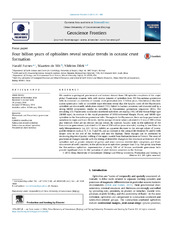Four billion years of ophiolites reveal secular trends in oceanic crust formation
Peer reviewed, Journal article
Published version
Permanent lenke
https://hdl.handle.net/1956/9545Utgivelsesdato
2014-07Metadata
Vis full innførselSamlinger
- Department of Earth Science [1050]
Originalversjon
https://doi.org/10.1016/j.gsf.2014.02.002Sammendrag
We combine a geological, geochemical and tectonic dataset from 118 ophiolite complexes of the major global Phanerozoic orogenic belts with similar datasets of ophiolites from 111 Precambrian greenstone belts to construct an overview of oceanic crust generation over 4 billion years. Geochemical discrimination systematics built on immobile trace elements reveal that the basaltic units of the Phanerozoic ophiolites are dominantly subduction-related (75%), linked to backarc processes and characterized by a strong MORB component, similar to ophiolites in Precambrian greenstone sequences (85%). The remaining 25% Phanerozoic subduction-unrelated ophiolites are mainly (74%) of Mid-Ocean-Ridge type (MORB type), in contrast to the equal proportion of Rift/Continental Margin, Plume, and MORB type ophiolites in the Precambrian greenstone belts. Throughout the Phanerozoic there are large geochemical variations in major and trace elements, but for average element values calculated in 5 bins of 100 million year intervals there are no obvious secular trends. By contrast, basaltic units in the ophiolites of the Precambrian greenstones (calculated in 12 bins of 250 million years intervals), starting in late Paleo- to early Mesoproterozoic (ca. 2.0–1.8 Ga), exhibit an apparent decrease in the average values of incompatible elements such as Ti, P, Zr, Y and Nb, and an increase in the compatible elements Ni and Cr with deeper time to the end of the Archean and into the Hadean. These changes can be attributed to decreasing degrees of partial melting of the upper mantle from Hadean/Archean to Present. The onset of geochemical changes coincide with the timing of detectible changes in the structural architecture of the ophiolites such as greater volumes of gabbro and more common sheeted dyke complexes, and lesser occurrences of ocelli (varioles) in the pillow lavas in ophiolites younger than 2 Ga. The global data from the Precambrian ophiolites, representative of nearly 50% of all known worldwide greenstone belts provide significant clues for the operation of plate tectonic processes in the Archean.

